HNB3209 - Maintaining Professional Healthcare Standards
Added on 2020-03-01
41 Pages10656 Words40 Views
Managing the needs of an individual presenting with small bowel
obstruction: A care study: Maintaining professional healthcare standards
Name of the student:
Name of the university:
Author note:
obstruction: A care study: Maintaining professional healthcare standards
Name of the student:
Name of the university:
Author note:
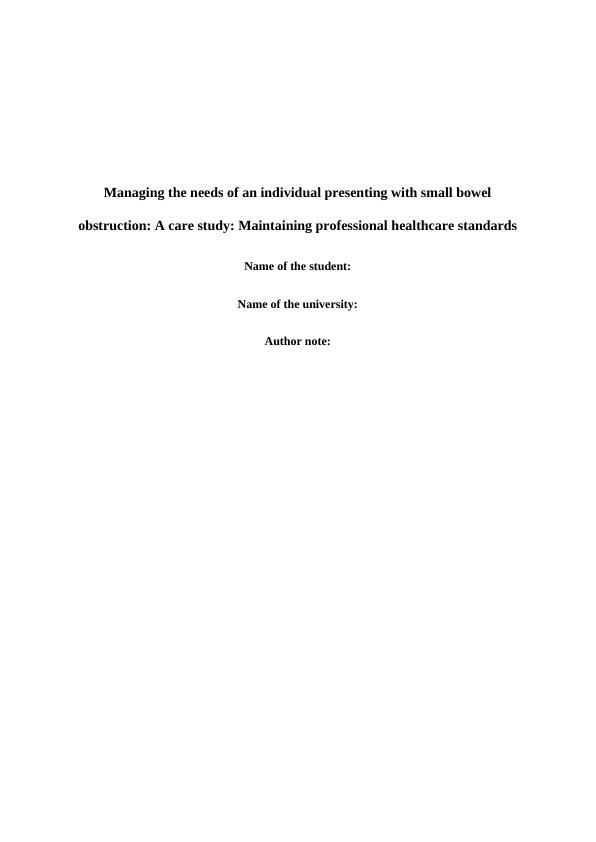
Introduction
Small bowel obstruction or SBO is a now-a-days the most common problem which
leads to an emergency to do an immediate surgery. This complication has increased to 5% of
frequent admissions to the hospitals (Brown and Dawson, 2009). In this disease urgent
treatment is needed because SBO is basically a lethal and life threatening. It causes difficulty
in bowel movement, perforation, ischemia, peritonitis sepsis and also may lead to death
(Moran, 2007). In fact Moran stated that the risk of complications of SBO in the patients is
high with 30% of patient suffering from bowel strangulation and 15% suffering from bowel
necrosis.
Diagnosis at initial stage and treatment includes situation up where these
complications are clear, and surgery is required. If not then, a non-operative trial of
moderately dealing with the patient's side effects may be suitable to check whether the
blockage is settling by own (Catena et al. 2011).
Since the dangers of complications are high in SBO, it is important that the nurses
precisely distinguish the patient's needs (Barrett, Wilson and Woollands 2012). Particularly
since the nurses have an expert duty of care to give superior requirements of care, and are
responsible for their activities and exclusions (NMC 2008). For this reason, nursing models
are helpful in giving a structure to guide the nurses about the nursing care (Pridmore, Murphy
and William, 2010). These nursing models are utilized in a combined way to execute and
assess patient care. Combination of these nursing processes is used to assess the
complications, planning, implementation and evaluation of patient care. These nursing
models are used to promote a systematic, holistic, comprehensive, and critical thinking
approach for delivering nursing care to individual persons (Matthews et al. 2010).
Small bowel obstruction or SBO is a now-a-days the most common problem which
leads to an emergency to do an immediate surgery. This complication has increased to 5% of
frequent admissions to the hospitals (Brown and Dawson, 2009). In this disease urgent
treatment is needed because SBO is basically a lethal and life threatening. It causes difficulty
in bowel movement, perforation, ischemia, peritonitis sepsis and also may lead to death
(Moran, 2007). In fact Moran stated that the risk of complications of SBO in the patients is
high with 30% of patient suffering from bowel strangulation and 15% suffering from bowel
necrosis.
Diagnosis at initial stage and treatment includes situation up where these
complications are clear, and surgery is required. If not then, a non-operative trial of
moderately dealing with the patient's side effects may be suitable to check whether the
blockage is settling by own (Catena et al. 2011).
Since the dangers of complications are high in SBO, it is important that the nurses
precisely distinguish the patient's needs (Barrett, Wilson and Woollands 2012). Particularly
since the nurses have an expert duty of care to give superior requirements of care, and are
responsible for their activities and exclusions (NMC 2008). For this reason, nursing models
are helpful in giving a structure to guide the nurses about the nursing care (Pridmore, Murphy
and William, 2010). These nursing models are utilized in a combined way to execute and
assess patient care. Combination of these nursing processes is used to assess the
complications, planning, implementation and evaluation of patient care. These nursing
models are used to promote a systematic, holistic, comprehensive, and critical thinking
approach for delivering nursing care to individual persons (Matthews et al. 2010).
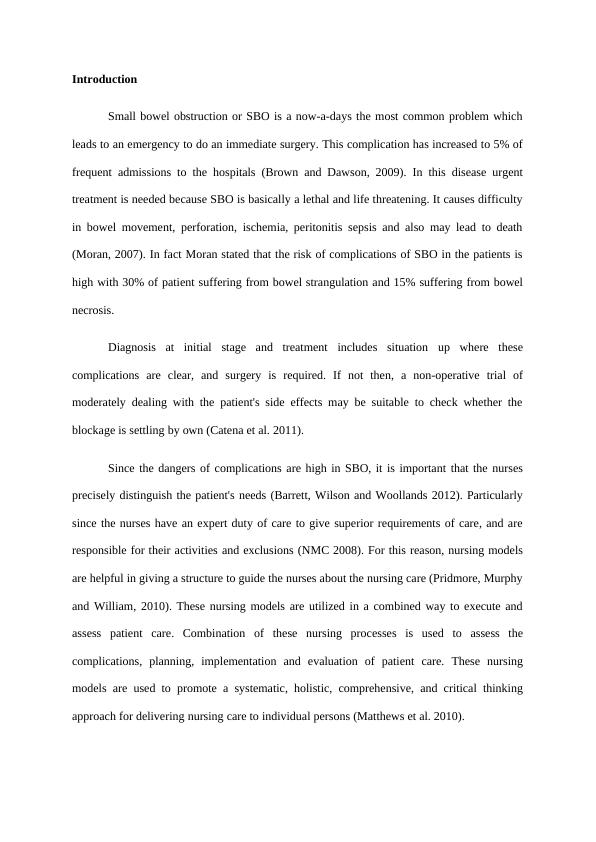
This task portrays the traditional nursing administration of a person with SBO on
admission to a surgical ward amid a 48 hour time on the basis of an altered type of the Roper-
Logan-Tierney demonstrate. A pseudonym is used through to secure patient classification as
per the Nursing and Midwifery Council, NMC (2008). The article incorporates foundation on
the symptoms, history and SBO itself. It additionally gives a basic review of nursing models
and a discussion of the Roper-Logan-Tierney Model.
A framework of the nursing procedure is then included, in addition to a more point by
point portrayal of the surveying, arranging, actualizing, and assessing steps engaged with
giving patient-focused care to the person. Proposals for nursing practice and a short
conclusion are likewise included.
Patient Presentation
Louise Wilson is a 34 year old single woman who used lives alone and is a business
counsellor. Recently, she experienced an open surgery for a punctured colon because of
Crohn's Colitis. The surgical strategy included a pan-colostomy with the formation of
ileostome and she had recovered well without complications. She is not taking any
medicines. However, Louise was admitted after 3 months to the regional hospital in the
emergency department complaining of a severe onset of stomach pain that happened in
irregular waves. This torment was joined by serious episodes of queasiness, Louise's
ileostomy had stopped to capacity, and she had stomach distension. Louise's stomach size
was measured as 70cm and stomach auscultation by a specialist revealed unusual bowel
sounds. A chest x-beam was unremarkable and a plain stomach radiograph was uncertain. In
this way, in contact with the radiographers, Louise experienced a CT check with differentiate
which appeared two enlarged circles of gut, driving the specialists to determine Louise to
admission to a surgical ward amid a 48 hour time on the basis of an altered type of the Roper-
Logan-Tierney demonstrate. A pseudonym is used through to secure patient classification as
per the Nursing and Midwifery Council, NMC (2008). The article incorporates foundation on
the symptoms, history and SBO itself. It additionally gives a basic review of nursing models
and a discussion of the Roper-Logan-Tierney Model.
A framework of the nursing procedure is then included, in addition to a more point by
point portrayal of the surveying, arranging, actualizing, and assessing steps engaged with
giving patient-focused care to the person. Proposals for nursing practice and a short
conclusion are likewise included.
Patient Presentation
Louise Wilson is a 34 year old single woman who used lives alone and is a business
counsellor. Recently, she experienced an open surgery for a punctured colon because of
Crohn's Colitis. The surgical strategy included a pan-colostomy with the formation of
ileostome and she had recovered well without complications. She is not taking any
medicines. However, Louise was admitted after 3 months to the regional hospital in the
emergency department complaining of a severe onset of stomach pain that happened in
irregular waves. This torment was joined by serious episodes of queasiness, Louise's
ileostomy had stopped to capacity, and she had stomach distension. Louise's stomach size
was measured as 70cm and stomach auscultation by a specialist revealed unusual bowel
sounds. A chest x-beam was unremarkable and a plain stomach radiograph was uncertain. In
this way, in contact with the radiographers, Louise experienced a CT check with differentiate
which appeared two enlarged circles of gut, driving the specialists to determine Louise to
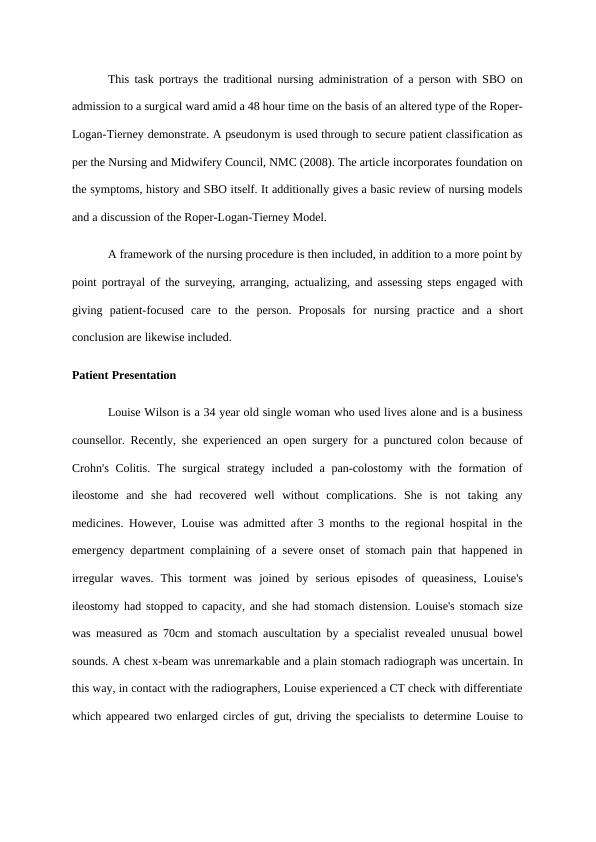
have incomplete mechanical little gut impediment. Louise at that point had a nasogastric tube
embedded to decompress her gut also, was therefore admitted to a surgical ward.
Small Bowel Obstruction
Small bowel obstruction happens when typical peristaltic transport of intestinal
substance and flatus is essentially impeded, blocked, or totally obstructed (Ansari, 2014). The
side effects incorporate colicky stomach torment, queasiness, spewing, stomach distension,
the runs or, on the other hand stoppage and anomalous gut sounds (Kent, 2007; Moran,
2007). These side effects may emerge from one of the wide range of sorts of inside
impediment which are grouped as indicated by their fulfillment, nature, area, seriousness,
etiology and timing (Appendix 1) (Kent, 2007; Di Saverio et al., 2013).
In small bowel obstruction, the food that are eaten are not digested by the digestive
juices hence the food does not dilate (Kent, 2007). The gastrointestinal liquid at that point
ends up plainly hypertonic and draws liquid osmotically from the body into the intestinal
lumen, additionally distending the inside (Monahan, Neighbors and Green, 2011). As the
bowel dilates, it increases the peristaltic movement in an attempt by the body to overcome the
barrier – causing the irregular bowel sounds and cause pain in stomach (Brunicardi et al.,
2010).
Various factors can cause check of the inside lumen, counting affected defecation,
outside bodies, parasites, tumors, gallstones, provocative strictures, bonds, hernias and
volvulus. In any case, intra-stomach grips are the most normal reason for mechanical little
bowel block in the created world (Stephenson and Singh, 2011). Patients who have had past
stomach or gynecological surgery are especially in danger, representing upto 75% of cases
(Diaz et al., 2013). In this way, not just is it vital to stay away from surgical mediations due
to the characteristic dangers they convey, surgery could likewise advance further repeats of
embedded to decompress her gut also, was therefore admitted to a surgical ward.
Small Bowel Obstruction
Small bowel obstruction happens when typical peristaltic transport of intestinal
substance and flatus is essentially impeded, blocked, or totally obstructed (Ansari, 2014). The
side effects incorporate colicky stomach torment, queasiness, spewing, stomach distension,
the runs or, on the other hand stoppage and anomalous gut sounds (Kent, 2007; Moran,
2007). These side effects may emerge from one of the wide range of sorts of inside
impediment which are grouped as indicated by their fulfillment, nature, area, seriousness,
etiology and timing (Appendix 1) (Kent, 2007; Di Saverio et al., 2013).
In small bowel obstruction, the food that are eaten are not digested by the digestive
juices hence the food does not dilate (Kent, 2007). The gastrointestinal liquid at that point
ends up plainly hypertonic and draws liquid osmotically from the body into the intestinal
lumen, additionally distending the inside (Monahan, Neighbors and Green, 2011). As the
bowel dilates, it increases the peristaltic movement in an attempt by the body to overcome the
barrier – causing the irregular bowel sounds and cause pain in stomach (Brunicardi et al.,
2010).
Various factors can cause check of the inside lumen, counting affected defecation,
outside bodies, parasites, tumors, gallstones, provocative strictures, bonds, hernias and
volvulus. In any case, intra-stomach grips are the most normal reason for mechanical little
bowel block in the created world (Stephenson and Singh, 2011). Patients who have had past
stomach or gynecological surgery are especially in danger, representing upto 75% of cases
(Diaz et al., 2013). In this way, not just is it vital to stay away from surgical mediations due
to the characteristic dangers they convey, surgery could likewise advance further repeats of
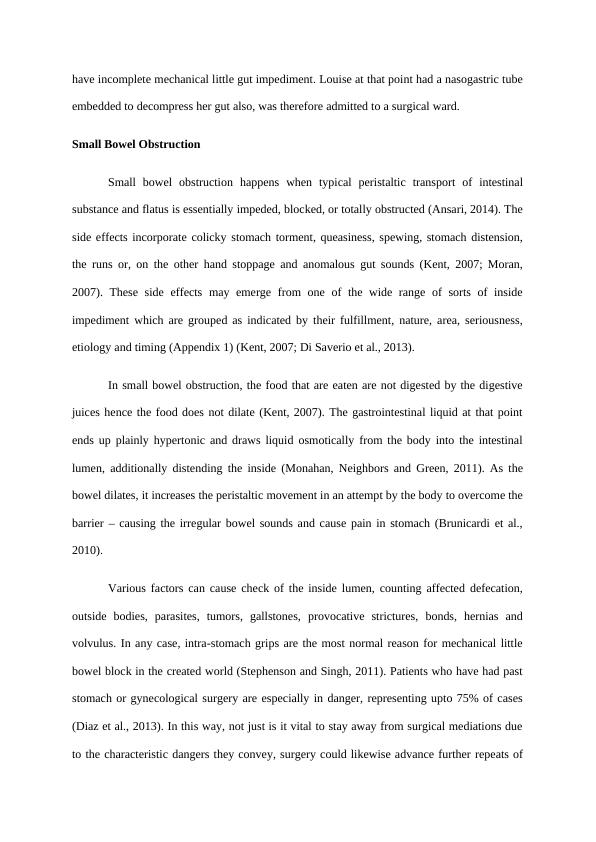
entrail deterrent (Catena et al., 2011; Di Saverio et al., 2013). Therefore, the part of medical
caretakers in giving excellent care amid preservationist administration is fundamental with
the goal that surgery is in this manner kept away from.
Nursing Theory and Models
Nursing is regularly characterized as a teach that includes looking after individuals as
to their wellbeing (Royal College of Nursing (RCN), 2003; International Council of Nurses
(ICN), 2014; World Health Organization (WHO), 2014; American Nurses Association
(ANA), 2014). It includes clinical judgment (RCN, 2003), self-governing and community
oriented care (ICN, 2014; WHO, 2014) and treatment of the human reaction to ailment
(ANA, 2014). While these definitions are valuable, in any case, they neglect to catch the
substance of nursing and what makes this discipline interesting (RCN, 2003).
Over the recent couple of years, to set up nursing as a discipline different from other
health experts has been a vital objective of nursing scholars (Murphy, Williams and
Pridmore, 2010). This has led to a move far from the medicinal model whose system is
esteemed unseemly to control nursing care (McKenna and Slevin, 2011). Subsequently,
different hypotheses and model systems have been produced which consolidate the 4 basic
components used to characterize nursing, known as the 'metaparadigm of nursing', of
individual, condition, wellbeing and nursing (McKenna, Pajnkihar and Murphy, 2014).
Specifically, nursing models are used to inform the nurses what is vital and relevant when
conveying individualized care (Barrett, Wilson and Woollands, 2012) in view of
perspectives, convictions and qualities about these four focal ideas.
Various, US-based, nursing models and hypotheses exist including that of Roy, Orem, Peplau
and Carper (Peate, 2012; McKenna and Slevin, 2011) which all attention on various parts of
nursing. Roy's Adaptation display (RAM) sees wellbeing as the limit of an individual to
caretakers in giving excellent care amid preservationist administration is fundamental with
the goal that surgery is in this manner kept away from.
Nursing Theory and Models
Nursing is regularly characterized as a teach that includes looking after individuals as
to their wellbeing (Royal College of Nursing (RCN), 2003; International Council of Nurses
(ICN), 2014; World Health Organization (WHO), 2014; American Nurses Association
(ANA), 2014). It includes clinical judgment (RCN, 2003), self-governing and community
oriented care (ICN, 2014; WHO, 2014) and treatment of the human reaction to ailment
(ANA, 2014). While these definitions are valuable, in any case, they neglect to catch the
substance of nursing and what makes this discipline interesting (RCN, 2003).
Over the recent couple of years, to set up nursing as a discipline different from other
health experts has been a vital objective of nursing scholars (Murphy, Williams and
Pridmore, 2010). This has led to a move far from the medicinal model whose system is
esteemed unseemly to control nursing care (McKenna and Slevin, 2011). Subsequently,
different hypotheses and model systems have been produced which consolidate the 4 basic
components used to characterize nursing, known as the 'metaparadigm of nursing', of
individual, condition, wellbeing and nursing (McKenna, Pajnkihar and Murphy, 2014).
Specifically, nursing models are used to inform the nurses what is vital and relevant when
conveying individualized care (Barrett, Wilson and Woollands, 2012) in view of
perspectives, convictions and qualities about these four focal ideas.
Various, US-based, nursing models and hypotheses exist including that of Roy, Orem, Peplau
and Carper (Peate, 2012; McKenna and Slevin, 2011) which all attention on various parts of
nursing. Roy's Adaptation display (RAM) sees wellbeing as the limit of an individual to
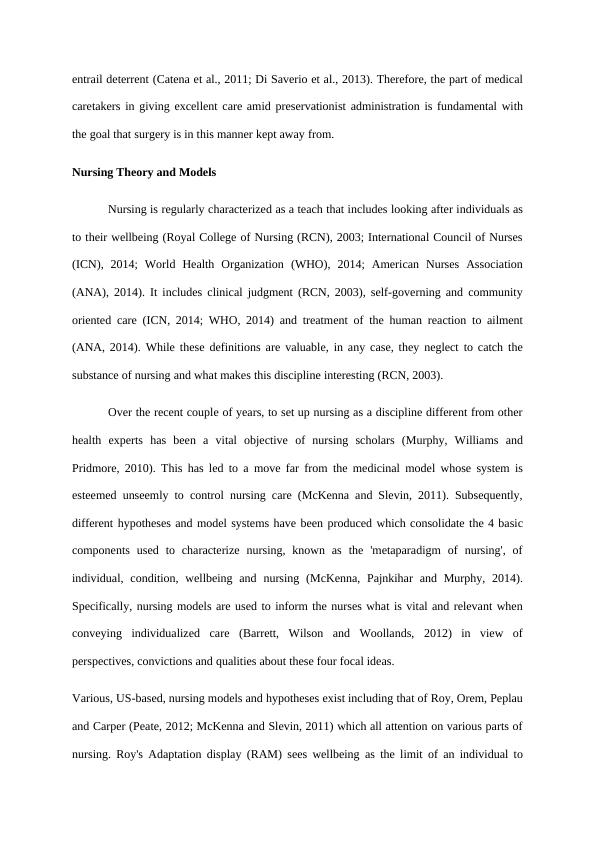
adjust to physiological, mental or social stressors (Walsh, 1998) and is generally relevant in
assorted wellbeing circumstances (Fawcett and Desanto-Madeya, 2012). Faultfinders of
RAM, in any case, contend the time has come expending to actualize and expects clients to
get it complex thoughts and broad language (Ingram, L, 1995; Fawcett and Desanto-Madeya,
2012). Interestingly, Peplau's hypothesis concentrates on building up patients' critical
thinking aptitudes through restorative relational connections, basically constraining its
application to emotional health settings (McKenna, Pajnkihar and Murphy, 2014).
In any case, the estimation of this model has been its commitment to understanding
the relational idea of the medical caretaker quiet relationship (Aggleton and Chalmers, 2000).
This basic part of nursing care is moreover consolidated into Carper's thoughts on the 4 sorts
of nursing learning (empirics, feel, morals and individual knowing), which have set a critical
point of reference for creating nursing information (McKenna and Slevin, 2011). Distinctive
again is Orem's self-mind shortage display which depends on the rationality that medical
caretakers help patients and their families to accomplish selfcare (Walsh, 1998). This model
is generally relevant in numerous different medicinal services settings and has advanced the
significance of patients adding to their care (Barrett, Wilson and Woollands, 2012).
In any case, it's pertinence to UK medicinal services is flawed on the grounds that it
was initially created for a USA protection based human services framework that is supported
by an alternate culture, set of qualities and nursing instruction program (McKenna, Pajnkihar,
and Murphy, 2014). Taken together, these cases show that nobody model can fit all nursing
circumstances, in this way nurture must pick a model that fits a patient's needs (McKenna and
Slevin, 2011).
RTL Model of Nursing
assorted wellbeing circumstances (Fawcett and Desanto-Madeya, 2012). Faultfinders of
RAM, in any case, contend the time has come expending to actualize and expects clients to
get it complex thoughts and broad language (Ingram, L, 1995; Fawcett and Desanto-Madeya,
2012). Interestingly, Peplau's hypothesis concentrates on building up patients' critical
thinking aptitudes through restorative relational connections, basically constraining its
application to emotional health settings (McKenna, Pajnkihar and Murphy, 2014).
In any case, the estimation of this model has been its commitment to understanding
the relational idea of the medical caretaker quiet relationship (Aggleton and Chalmers, 2000).
This basic part of nursing care is moreover consolidated into Carper's thoughts on the 4 sorts
of nursing learning (empirics, feel, morals and individual knowing), which have set a critical
point of reference for creating nursing information (McKenna and Slevin, 2011). Distinctive
again is Orem's self-mind shortage display which depends on the rationality that medical
caretakers help patients and their families to accomplish selfcare (Walsh, 1998). This model
is generally relevant in numerous different medicinal services settings and has advanced the
significance of patients adding to their care (Barrett, Wilson and Woollands, 2012).
In any case, it's pertinence to UK medicinal services is flawed on the grounds that it
was initially created for a USA protection based human services framework that is supported
by an alternate culture, set of qualities and nursing instruction program (McKenna, Pajnkihar,
and Murphy, 2014). Taken together, these cases show that nobody model can fit all nursing
circumstances, in this way nurture must pick a model that fits a patient's needs (McKenna and
Slevin, 2011).
RTL Model of Nursing
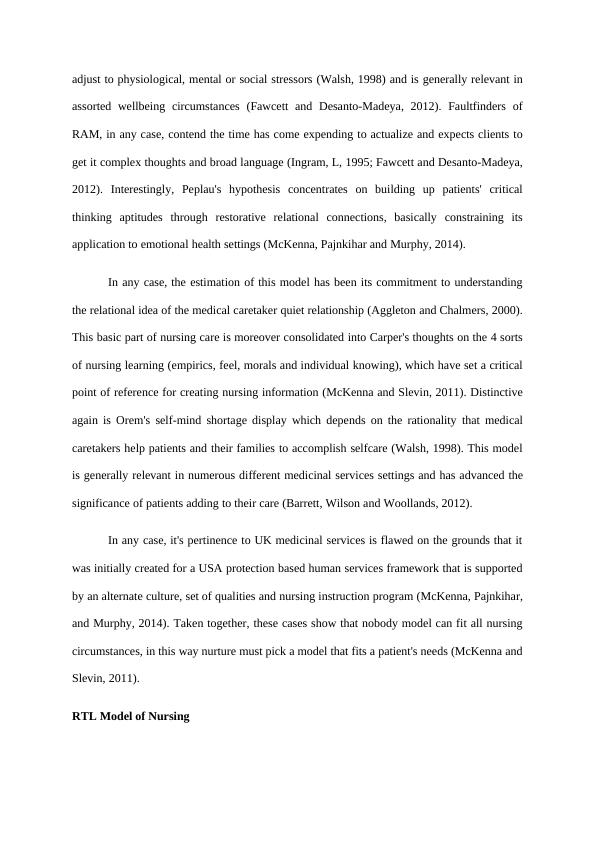
The Roper-Logan-Tierney (RLT) display was picked as a system to manage nursing care in
this task since it is the prevalent nursing model utilized as a part of the UK and is, thusly,
recognizable to most medical caretakers (Maxfield and Parker, 2012). This model was first
distributed by Roper, Logan and Tierney in 1980 to enable understudies to build up their
reasoning about nursing (Roper, Logan and Tierney, 2000).
The RLT model shows a movement from a disease based way to deal with mind
towards perceiving the all encompassing needs of an individual since it considers the
independence of a man, their exercises of living, the dependence-independence furthermore,
life expectancy continuums, and other affecting variables (Barrett, Wilson and Woollands,
2012). The last incorporate natural, mental, socio-social, ecological furthermore, politico-
monetary variables (Roper, Logan, Tierney, 2000). A focal concentration of the RLT show is
the part of attendants in helping people to forestall, mitigate, take care of or adapt to issues
identifying with 12 Activities of Living (ALs) (Aggleton and Chalmers, 2000). These ALs
cover an assortment of points that incorporate eating and drinking, right through to resting
and notwithstanding passing on as well (Appendix 2) (Brooker and Waugh, 2013). In
rehearse, attendants work in association with patients to survey every AL so as to
comprehend the patient's individual needs and recognize genuine or potential nursing issues
(Aggleton and Chalmers, 2000). While the advantage of this approach is its
straightforwardness and absence of language (Bellman, 1996), pundits contend it decreases
patients to an insignificant rundown of exercises (Walsh, 1998; McKenna, Pajnkihar and
Murphy, 2014). In any case, Bellman (1996) states that this blame is an outcome of the way
the RLT demonstrate is actualized, be that as it may, as opposed to being a issue with the
model itself (Walsh, 1998). At the point when utilized as a part of blend with the nursing
process, the RLT demonstrate advances the conveyance of precise, all encompassing and
individualized persistent care (Pridmore, Williams and Murphy, 2010).
this task since it is the prevalent nursing model utilized as a part of the UK and is, thusly,
recognizable to most medical caretakers (Maxfield and Parker, 2012). This model was first
distributed by Roper, Logan and Tierney in 1980 to enable understudies to build up their
reasoning about nursing (Roper, Logan and Tierney, 2000).
The RLT model shows a movement from a disease based way to deal with mind
towards perceiving the all encompassing needs of an individual since it considers the
independence of a man, their exercises of living, the dependence-independence furthermore,
life expectancy continuums, and other affecting variables (Barrett, Wilson and Woollands,
2012). The last incorporate natural, mental, socio-social, ecological furthermore, politico-
monetary variables (Roper, Logan, Tierney, 2000). A focal concentration of the RLT show is
the part of attendants in helping people to forestall, mitigate, take care of or adapt to issues
identifying with 12 Activities of Living (ALs) (Aggleton and Chalmers, 2000). These ALs
cover an assortment of points that incorporate eating and drinking, right through to resting
and notwithstanding passing on as well (Appendix 2) (Brooker and Waugh, 2013). In
rehearse, attendants work in association with patients to survey every AL so as to
comprehend the patient's individual needs and recognize genuine or potential nursing issues
(Aggleton and Chalmers, 2000). While the advantage of this approach is its
straightforwardness and absence of language (Bellman, 1996), pundits contend it decreases
patients to an insignificant rundown of exercises (Walsh, 1998; McKenna, Pajnkihar and
Murphy, 2014). In any case, Bellman (1996) states that this blame is an outcome of the way
the RLT demonstrate is actualized, be that as it may, as opposed to being a issue with the
model itself (Walsh, 1998). At the point when utilized as a part of blend with the nursing
process, the RLT demonstrate advances the conveyance of precise, all encompassing and
individualized persistent care (Pridmore, Williams and Murphy, 2010).

Nursing process
The nursing procedure was first presented by Yura and Walsh in 1967 (Barrett, Wilson and
Woollands, 2012) which, regardless of introductory feedback, acquainted a precise approach
with nursing care that advanced basic considering and clinical basic leadership (Huckabay,
2009; Castledine, 2011). Yura and Walsh (1967) initially depicted the nursing procedure as a
recurrent, dynamic 4-stage process including Assessment (A), Planning(P), Intervention(I)
and Evaluation(E) (known as 'APIE'). In later years, be that as it may, these means have been
adjusted and extended by a few creators with the goal that now 4, 5 or 6 stage renditions of
the nursing process exist (Barrett, Wilson and Woollands, 2012). Whichever adaptation is
utilized the primary motivation behind the nursing procedure is the same - to deliberately
distinguish a patient's real or potential social insurance needs, design and convey nursing
mediations to meet these distinguished necessities, and after that assess the viability of the
care gave (Kozier et al, 2012). Critically, an indispensable piece of this procedure includes
distinguishing and utilizing proof based rules to support all nursing care (Castledine, 2011).
By and large, the first 4 stage APIE adaptation is all the more generally utilized as a part of
the UK (Matthews, 2010) also, a 5 stage form is prevalently utilized as a part of North
America (Appendix 3) (Brooker and Waugh, 2013). The benefit of the APIE form is that it
has been regularly utilized, is commonplace to most human services experts, and the 4 phases
help distinguish a patient's needs rapidly and productively (Lloyd, 2010). In any case, the 5-
stage rendition incorporates a different nursing analyze venture between the evaluation and
arranging stages, allowing medical caretakers to methodicallly build up a nursing
determination to guarantee nursing issues are not disregarded (Barrett, Wilson and
Woollands, 2012). Despite the fact that determinations has for quite some time been viewed
as a basic stride in the nursing procedure (Hogston, 1997), the NMC don't yet expect medical
caretakers to receive nursing analyze as a center piece of arranging quiet care (NMC, 2010a).
The nursing procedure was first presented by Yura and Walsh in 1967 (Barrett, Wilson and
Woollands, 2012) which, regardless of introductory feedback, acquainted a precise approach
with nursing care that advanced basic considering and clinical basic leadership (Huckabay,
2009; Castledine, 2011). Yura and Walsh (1967) initially depicted the nursing procedure as a
recurrent, dynamic 4-stage process including Assessment (A), Planning(P), Intervention(I)
and Evaluation(E) (known as 'APIE'). In later years, be that as it may, these means have been
adjusted and extended by a few creators with the goal that now 4, 5 or 6 stage renditions of
the nursing process exist (Barrett, Wilson and Woollands, 2012). Whichever adaptation is
utilized the primary motivation behind the nursing procedure is the same - to deliberately
distinguish a patient's real or potential social insurance needs, design and convey nursing
mediations to meet these distinguished necessities, and after that assess the viability of the
care gave (Kozier et al, 2012). Critically, an indispensable piece of this procedure includes
distinguishing and utilizing proof based rules to support all nursing care (Castledine, 2011).
By and large, the first 4 stage APIE adaptation is all the more generally utilized as a part of
the UK (Matthews, 2010) also, a 5 stage form is prevalently utilized as a part of North
America (Appendix 3) (Brooker and Waugh, 2013). The benefit of the APIE form is that it
has been regularly utilized, is commonplace to most human services experts, and the 4 phases
help distinguish a patient's needs rapidly and productively (Lloyd, 2010). In any case, the 5-
stage rendition incorporates a different nursing analyze venture between the evaluation and
arranging stages, allowing medical caretakers to methodicallly build up a nursing
determination to guarantee nursing issues are not disregarded (Barrett, Wilson and
Woollands, 2012). Despite the fact that determinations has for quite some time been viewed
as a basic stride in the nursing procedure (Hogston, 1997), the NMC don't yet expect medical
caretakers to receive nursing analyze as a center piece of arranging quiet care (NMC, 2010a).
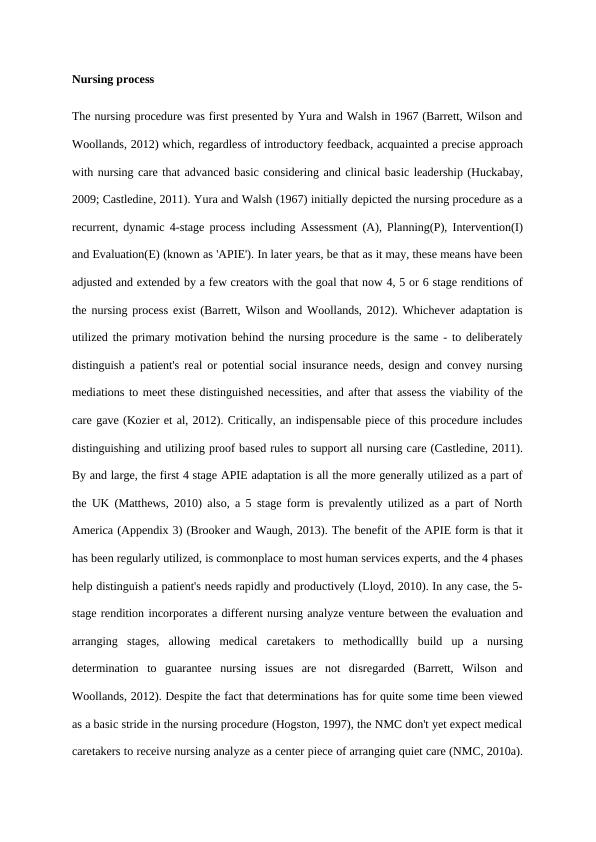
End of preview
Want to access all the pages? Upload your documents or become a member.
Related Documents
Nursing Case Study Of Patientlg...
|9
|2442
|43
The body temperature was higher with systolic hypertensionlg...
|12
|3251
|15
Biopsychosocial, Spiritual and Cultural Impacts | Case Study Assessmentlg...
|10
|2833
|53
Chronic Illness and Disability: Medication and Monitoring Priorities for Patient-Centered Carelg...
|8
|2324
|357
Clinical assessment of suicide risklg...
|9
|3464
|16
Nursing | Case Studies | Assignmentlg...
|9
|2520
|38
